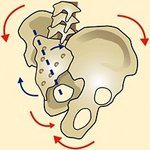Restless leg syndrome. Consumer Reports offers medical advice but may there be a better treatment?
Is Restless Leg Syndrome, (also known as Willis-Ekbom disease) a disease or just misunderstood by mainstream medicine? In 2011, the book Cheating Mother Nature’s chapter on the condition advised that mechanical problems in the pelvis and the surrounding musculature and joints are why people experience the condition. The condition is more common in females and may be caused by the width of their hips and its overall effect on their knees and their body structure.
The condition causes an uncontrollable urge to move the legs due to discomfort and a sensation that can be described as electrical by some or creepy-crawly and jittery by others.
According to Consumer Reports, about 7-8 percent of the population has this condition which, is sometimes treated with medication in more severe cases. Restless leg is felt when you are at rest, and laying down.
The mechanisms behind the condition are poorly understood medically. Perhaps, medicine should see it from a mechanical perspective as most chiropractors would.
 Pelvic distortion is most likely the reason for the condition, which is a response to how we are built. The symptoms of the disorder are felt in the, hips, feet and legs.
Pelvic distortion is most likely the reason for the condition, which is a response to how we are built. The symptoms of the disorder are felt in the, hips, feet and legs.
When a person is asymmetrically built, their pelvis will often distort. Over time, the myofascia, the connective tissue that covers the muscles and acts like an exoskeleton and guides movement will shorten and tighten, affecting how the pelvis functions at rest.
When a person with pelvic torsion sits or lays down, the muscles and structures will warm down and they will feel the tension in the legs and pelvis and want to move their legs to find a more comfortable position. If they stay in the position too long, they will likely experience a dull ache down the leg and hip, requiring them to move to a more comfortable and less achy position. Since symptoms are subjective, depending on the individual, different people may experience and report the discomfort in different ways.
Calling the condition a disease sounds plausible, however, it is a disease classified so the pharmaceutical industry can prescribe a medication for the problem and how is the track record for this type of approach?
The problem has a mechanical basis, as our office has treated dozens of these cases successfully over the years. Treating a condition that responds to a mechanical approach such as chiropractic is a good first approach before any medication is considered.
Consumer Reports recently authored a report on the condition was well researched however, I am not in agreement that this is a condition best treated medically, and it is written from a medical point of view. Chiropractic intervention should be considered first as it has few side effects and may actually aid in resolving the condition.
Read the Consumer Reports article below
5 Things to Know About Restless Legs Syndrome
Depending on the severity, it can be just an annoyance—or a disorder that seriously affects your quality of life
By Catherine Roberts September 23, 2017
If you’ve ever been reading a book or watching TV in the evening and felt a strange, powerful urge to move your legs, you may have experienced the characteristic symptom of restless legs syndrome (RLS), also known as Willis-Ekbom disease.
People may variously describe the feeling as creepy-crawly, jittery, or electrical. The hallmark of RLS is “the uncontrollable urge to move the leg, that comes on at rest [while awake],” says Suzanne Bertisch, M.D., a sleep physician at Beth Israel Deaconess Medical Center and an assistant professor of medicine at Harvard Medical School.
Symptoms of restless legs syndrome may affect as many as 7 to 8 percent of all U.S. adults, with 2 to 3 percent of people having cases severe enough to require medication.
Yet there’s a lot experts still don’t know about RLS, and it can be tricky to treat. For Restless Legs Syndrome Awareness Day, here are five things you should know about this condition.
Read more